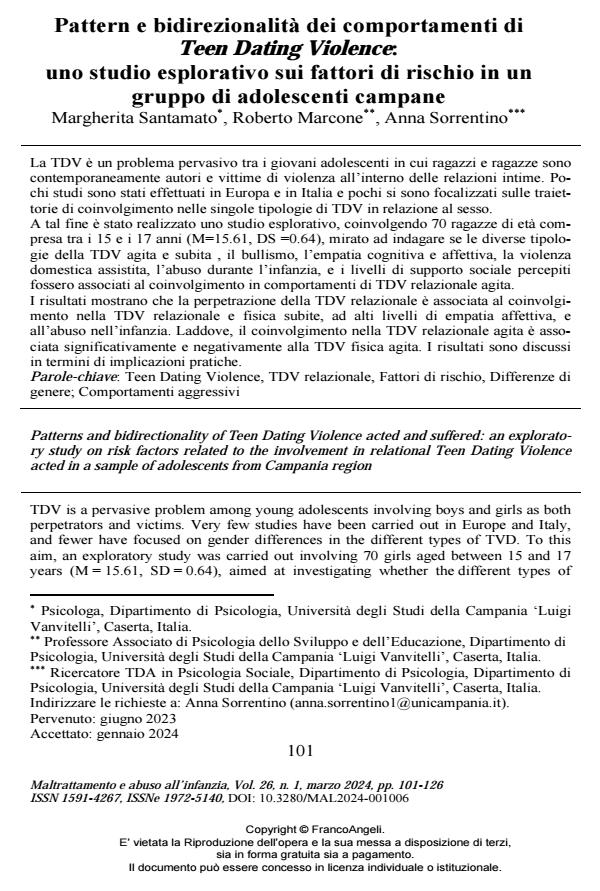Pattern e bidirezionalità dei comportamenti di Teen Dating Violence: uno studio esplorativo sui fattori di rischio in un gruppo di adolescenti campane
Titolo Rivista MALTRATTAMENTO E ABUSO ALL’INFANZIA
Autori/Curatori Margherita Santamato, Roberto Marcone, Anna Sorrentino
Anno di pubblicazione 2024 Fascicolo 2024/1
Lingua Italiano Numero pagine 26 P. 101-126 Dimensione file 259 KB
DOI 10.3280/MAL2024-001006
Il DOI è il codice a barre della proprietà intellettuale: per saperne di più
clicca qui
Qui sotto puoi vedere in anteprima la prima pagina di questo articolo.
Se questo articolo ti interessa, lo puoi acquistare (e scaricare in formato pdf) seguendo le facili indicazioni per acquistare il download credit. Acquista Download Credits per scaricare questo Articolo in formato PDF

FrancoAngeli è membro della Publishers International Linking Association, Inc (PILA)associazione indipendente e non profit per facilitare (attraverso i servizi tecnologici implementati da CrossRef.org) l’accesso degli studiosi ai contenuti digitali nelle pubblicazioni professionali e scientifiche
La TDV è un problema pervasivo tra i giovani adolescenti in cui ragazzi e ragazze sono contemporaneamente autori e vittime di violenza all’interno delle relazioni in-time. Pochi studi sono stati effettuati in Europa e in Italia e pochi si sono focalizzati sulle traiettorie di coinvolgimento nelle singole tipologie di TDV in relazione al sesso. A tal fine è stato realizzato uno studio esplorativo, coinvolgendo 70 ragazze di età compresa tra i 15 e i 17 anni (M=15.61, DS =0.64), mirato ad indagare se le diverse tipologie della TDV agita e subita , il bullismo, l’empatia cognitiva e affettiva, la vio-lenza domestica assistita, l’abuso durante l’infanzia, e i livelli di supporto sociale percepiti fossero associati al coinvolgimento in comportamenti di TDV relazionale agita. I risultati mostrano che la perpetrazione della TDV relazionale è associata al coinvol-gimento nella TDV relazionale e fisica subite, ad alti livelli di empatia affettiva, e all’abuso nell’infanzia. Laddove, il coinvolgimento nella TDV relazionale agita è as-sociata significativamente e negativamente alla TDV fisica agita. I risultati sono di-scussi in termini di implicazioni pratiche.
Parole chiave:Teen Dating Violence, TDV relazionale, Fattori di rischio, Differenze di genere; Comportamenti aggressivi
Margherita Santamato, Roberto Marcone, Anna Sorrentino, Pattern e bidirezionalità dei comportamenti di Teen Dating Violence: uno studio esplorativo sui fattori di rischio in un gruppo di adolescenti campane in "MALTRATTAMENTO E ABUSO ALL’INFANZIA" 1/2024, pp 101-126, DOI: 10.3280/MAL2024-001006